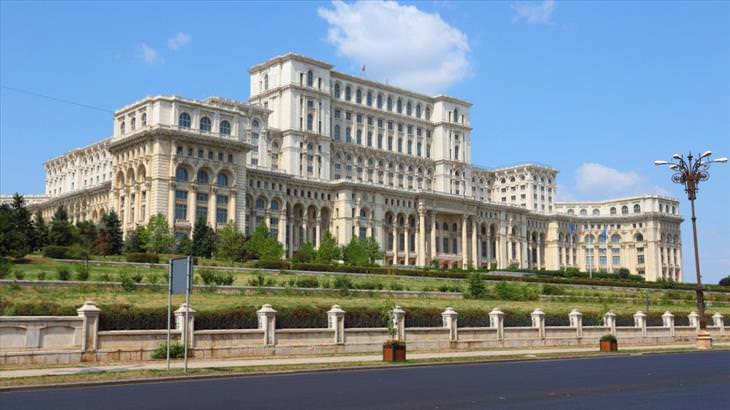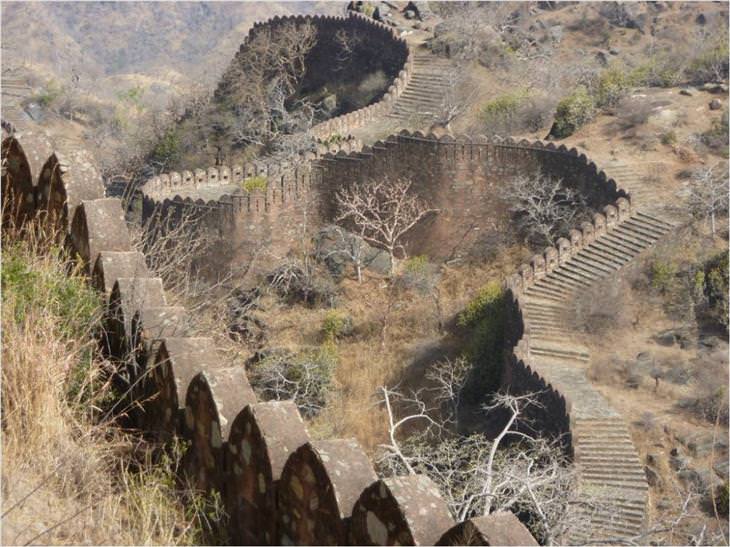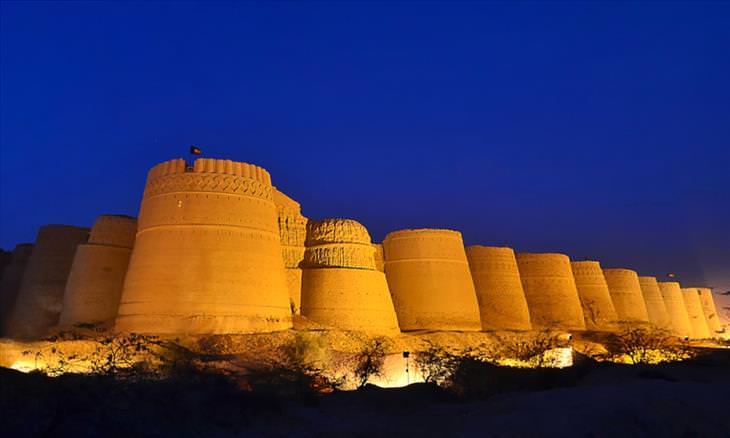
This awe-inspiring edifice, which is more than a century old and is listed as a UNESCO World Heritage site, is situated in the West African country of Mali. It is a monumental testament to ancient construction techniques, and it's a melancholic fact that it remains closed to tourists.
Notably, this majestic structure is renowned as the largest mud-brick building in the world, a record-breaking feat that adds an extra layer of fascination to its historical and cultural importance. The building's exterior is a marvel to behold, an intricate melding of clay and wood, patiently shaped by the hands of dedicated builders who followed the traditional methods of their ancestors.

The building's grandeur is accentuated by the natural, earthy tones of the sun-dried mud-bricks, which are harmoniously blended with the landscape, a timeless reminder of the symbiosis between man and nature. Its unique architectural style stands as a beacon of the region's historical identity and is an enduring symbol of Mali's rich cultural heritage.
Although visitors may not be allowed to explore the building's inner sanctum, the exterior spectacle itself is a captivating sight to behold. Its sheer scale and the intricate detailing of the mud-brick facade tell a story of cultural tenacity, architectural ingenuity, and a deep-rooted connection to the environment. Despite its closure to tourism, the building continues to inspire and educate, a testament to the enduring power of cultural heritage.
The Chand Baori, an architectural marvel, is a remarkable inverted-pyramid structure nestled in the humble village of Abhaneri, India. Its origin is shrouded in mystery, with historians and experts still debating its exact age. It's an intricately designed stepwell, one of the deepest and oldest in the world. The structure houses a staggering 3,500 narrow steps, arranged symmetrically on three of its inner walls, descending to a tranquil green pool at the bottom.

It's more akin to an exquisite piece of art than a mere well, a testament to the architectural ingenuity of ancient Indian builders. Its design, centered on functionality and aesthetics, is an example of human adaptation to the harsh, dry climate, providing a reliable water source while remaining an awe-inspiring sight.

Spanning an impressive 12 stories above ground and plunging eight levels below, it stands as the world's largest and most expensive parliament building. This monumental structure, a testament to human ingenuity and ambition, is home to an astonishing 3,000 rooms. Each room is designed with a sense of extravagance, a reflection of the absolute power and control held by the state during that period.

Its imposing presence in the heart of the Romanian capital is impossible to ignore. The building's excessive scale and opulent design are a stark contrast to the austerity experienced by the Romanian people during the Soviet era, a reminder of the harsh realities of a divided world.
The Palace of the Parliament is not just an architectural marvel; it's a symbol of a turbulent period in history. Its walls echo the political rhetoric of a bygone era, while its grand halls and rooms bear silent testimony to the paradoxes of power. Despite its controversial history, the building stands as a powerful reminder of the past, a historical artifact in the heart of modern Romania.
The destruction of the ancient Mostar Bridge during the Bosnian War of 1992-1995 was a heartrending event, a blow to a shared cultural heritage and a symbol of unity in the divided city. The bridge, a magnificent structure arching over the Neretva River, was more than just a physical connection; it was a testament to the indomitable human spirit and the shared history of the people of Mostar.
However, the resilient people of Mostar did not let this tragedy mark the end of their bridge. Rising from the ashes of war, the community rallied to rebuild this symbol of unity. The reconstruction project, completed in 2005, restored the bridge to its former glory, and it was subsequently designated a UNESCO World Heritage Site.

The new Mostar Bridge is a compelling symbol of resilience and reconciliation. Its beautiful arch once again straddles the icy Neretva River, reconnecting the city's divided halves. The local custom of bungee jumping from the bridge continues, a thrilling tradition that defies the river's icy temperatures for most of the year. This daring act is a testament to the courage and enduring spirit of the Mostar people.
Today, the Mostar Bridge is not just a crossing point over a river, but a beacon of hope, a symbol of triumph over adversity. It stands as a testament to the unyielding spirit of humanity, a reminder that even in the face of destruction, we have the capacity to rebuild.
The Kumbhalgarh Fort, an imposing structure nestled in the rugged landscape of India, is a breathtaking testament to the grandeur of historical military architecture. This monument is fortified by a massive wall, fittingly referred to as the 'Guardian of Death'. The wall's impressive length of 22 miles and height of around 25 feet stand as a formidable testament to the strategic defense mechanisms employed during the 15th and 16th centuries.
Constructed painstakingly over a century, this awe-inspiring wall speaks volumes about the dedication, planning, and craftsmanship that went into its making. The fact that it was never breached or even marred by enemy forces attests to its strategic design and the remarkable military acumen of the time.

Today, the colossal structure continues to dominate the landscape, an enduring symbol of India's rich architectural heritage and military history. Its imposing presence against the backdrop of the Aravalli Range leaves visitors awestruck, providing a window into the country's past. The Kumbhalgarh Fort, with its 'Guardian of Death', stands as a proud beacon of India's historical legacy, an architectural marvel that continues to tell us its tales of courage and resilience.
This unique structure was specifically designed for the private use of the women residing in the Shah's harem. As such, it was meticulously crafted to meet their spiritual needs within their private quarters, a reflection of the social norms and cultural intricacies of that era.
The mosque's exterior might seem unassuming at first glance, but within, it houses an array of stunning architectural and decorative elements. The walls are adorned with intricate mosaics, frescoes, and calligraphy, adding a sense of serene beauty to the place of worship. The absence of minarets and courtyards, which are usually bustling with activity, allows for a more intimate and quieter atmosphere, encouraging introspection and tranquility.
This unique mosque is a testament to the rich history and cultural diversity of the Safavid period in Iran. It encapsulates a specific moment in time when the religious and private lives of women were given significant architectural consideration. Despite its unconventional design, it is an irreplaceable part of Iran's religious and architectural heritage, echoing the voices of the women who once sought solace within its walls.
Derawar Fort, an architectural gem from the 18th century, is an awe-inspiring edifice nestled in the heart of Pakistan. Surprisingly, even the locals around Derawar appear somewhat indifferent or unaware of this colossal structure in their midst.
This imposing fort is characterized by its square shape, an unusual design that sets it apart from most traditional fortifications. Its massive walls, reaching a staggering 100 feet above the ground, dominate the surrounding landscape, a testament to the architectural prowess of its builders. The fortress's perimeter extends to an impressive 5,000 feet, creating a formidable sight that is hard to ignore.

Despite its grandeur, the fort exudes an aura of serene solitude, its majestic walls standing as silent witnesses to the passage of time. The fort's bricks have been bleached white by the relentless sun, giving it an ethereal quality that contrasts sharply with the barren landscape. The fort's austere exterior belies its rich history, which is steeped in tales of war, conquest, and survival.
In the face of modernity, the Derawar Fort remains a poignant reminder of a bygone era. Its sheer size and distinctive design make it a significant architectural landmark. Yet, despite its grandeur, it remains largely unappreciated, a hidden gem awaiting recognition from the world. This enormous, square-shaped giant is a silent testament to the rich cultural heritage of Pakistan, a monument that deserves our attention and admiration.